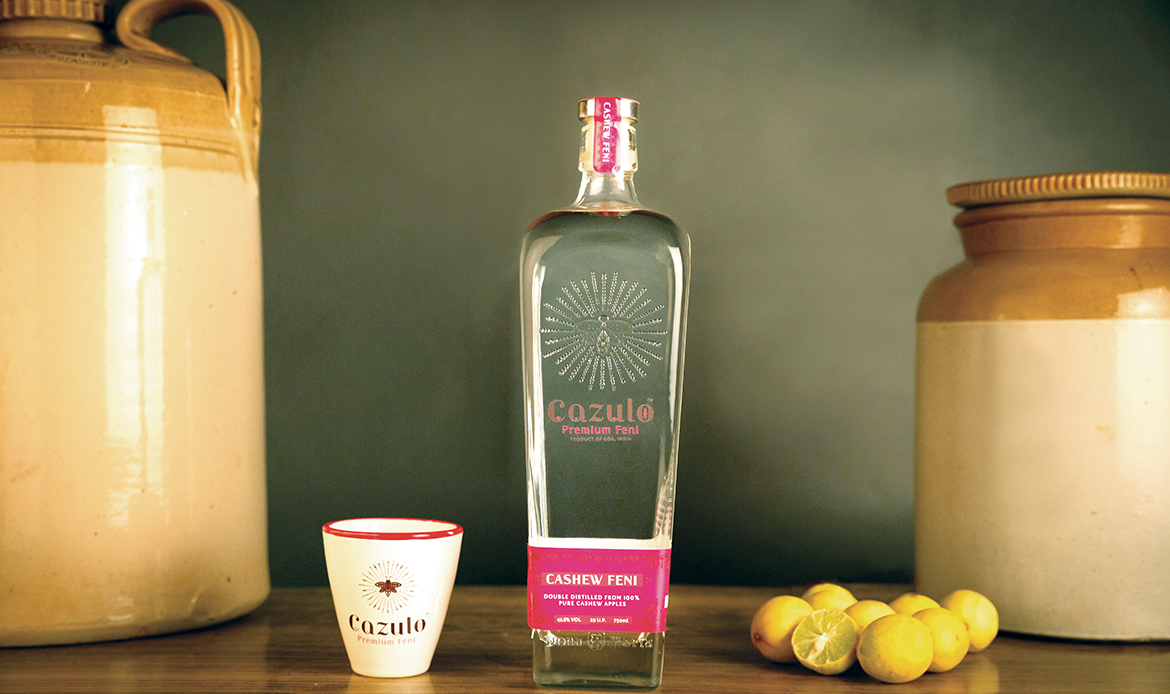The afternoon sun is blazing on the back of my neck, and the dry red lateritic soil crunches as I climb through the cashew orchard on the hill. It’s two in the afternoon, siesta time for most in this erstwhile Portuguese colony of Goa.
A gentle breeze caresses the hanging luscious juicy red cashew, beckoning it to fall. The magic is about to happen.
We were lucky – just like chilly, tomato, potato and a few more exotics, cashew too was not native to Goa. This ‘alien’ hopped across continents and sailed across oceans to finally land on the western shores of India.
Cashew took to our red soil and tropical climate so beautifully that today we call it our own. By the year 1740, Portuguese spies were already secretly documenting how Goans enjoyed an alcohol distilled from this exotic fruit, unlike anywhere else in the world. Our ancestors were already inventors!

If you want to make good cashew Feni, you have to first begin with picking the right cashew fruits. The local variety, the ‘Balli’, is coloured in gentle yellows, oranges and vibrant reds. It is best suited for Feni production, as opposed to the emaciated, monochrome ‘hybrids’ these days.

Early afternoon is when the cazkars (workers) organise themselves to methodically comb the orchards for naturally fallen cashew apples. Dressed like Ninjas (1) – covered from head to toe, to avoid insect bites and scratches – they arm themselves with a canto to spear fallen fruit into a basket (2).
Tree-ripened fruits are full of sugars and low in the astringent sap, so make the best Feni. Cashew apples are dropped into the colmbi, stone basins carved into solid rock (3), where another set of workers (4) de-seed the nuts from the cashew apples, to prepare for the stomp.

Stomping the pulpy fruit (1) to gently express the juices may look like fun, but it is serious work. The pulp is then made into in a mound and trussed together with a vine. Heavy rocks are left overnight on the top (2) to press the remaining juice out of the pulp. The juice is strained and allowed to naturally ferment in earthen pots (3). No nutrients, catalysts or artificial yeasts are added. Nature takes over from where man left off, converting natural sugars into alcohols.

After fermentation, when the wash stops bubbling, it is ready for distillation. This crude cashew wine is transferred into the pot still. Traditionally Feni was distilled in purposefully crafted earthen pots, now replaced by more practical copper pots. The vapours cool in copper coils and are collected in an earthen pot called a launi.
Traditionally the alcohol vapours were condensed in an earthen pot, by constantly pouring water over the launi with a coconut shell ladle. Now a copper coil is immersed in a water tank to do it. The vapour phase of the alcohol is most crucial, while the copper coil removes unwanted sulphates, the earthen pot imparts earthy notes to the spirit.

Urrack (14-16% v/v) is a lovely cooling drink, and is velvety smooth. Unlike other alcohols, Feni is directly distilled into 42.8% alcohol, says Cazulo Feni owner, Hansel Vaz.

Fine Feni is stored in glass, and not oak, as wood has nothing more to provide to an already robust and flavourful spirit. Carboys and Demi-Johns round off and chip any rough edges if there were as the Feni is allowed recuperate from the tumultuous distillation process for at least a year.

Finally, the Feni is tasted, graded and bottled into Cazulo Premium Cashew Feni bottles, that would grace bar shelves or a table of lively conversation. As they say in (Portuguese-speaking) Goa, “Saude!”














